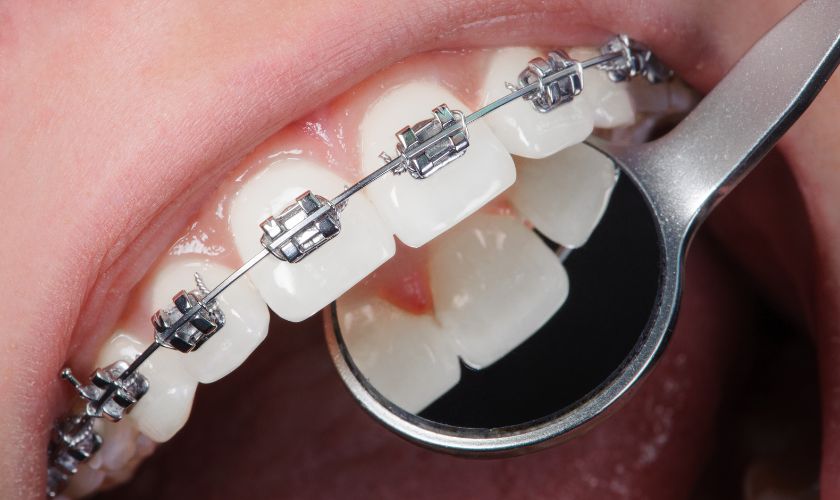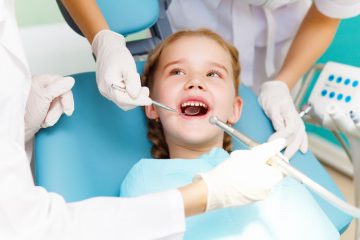You might need orthodontic treatment if you notice crooked or crowded teeth, gaps that trap food, or difficulty with your bite. Persistent jaw pain, discomfort, or trouble chewing and speaking can also signal alignment issues. Don’t ignore signs like teeth grinding, as these problems can worsen over time. Even adults can benefit from effective treatments, improving both function and appearance. Addressing these concerns early can prevent more serious dental issues later on. If you’re wondering about your specific situation and available options, you’ll find valuable insights in the information that follows.
Crooked or Crowded Teeth
Many people often overlook the signs of crooked or crowded teeth, but these issues can greatly impact both oral health and self-esteem. You might find that overlapping teeth make it difficult to floss or brush properly, leading to an increased risk of cavities and gum disease. Fortunately, there are various orthodontic options available, such as traditional braces, clear aligners, and lingual braces, each tailored to fit different needs and preferences.
When considering treatment, age plays a significant role. While many associate orthodontics with teenagers, adults are increasingly seeking treatment for aesthetic benefits and improved functionality. Treatment timelines can vary; you could expect anywhere from several months to a few years, depending on the severity of your case.
After undergoing orthodontic treatment, maintenance tips are essential for lasting results. Regular dental check-ups and proper oral hygiene will help maintain your smile. Remember, investing in your dental health not only enhances your appearance but also contributes to your overall well-being. Don’t hesitate to consult an orthodontist to explore the best options for your unique situation.
Gaps Between Teeth
While crooked or crowded teeth can pose significant challenges, gaps between teeth also deserve attention. These noticeable spaces can trap food, making dental hygiene more difficult and potentially leading to tooth decay. If you’re experiencing gaps, consider exploring various gap closure options available through orthodontic treatment.
Orthodontic appliances, such as braces or clear aligners, are effective tools for closing gaps and achieving aesthetic improvements in your smile. They work by gradually shifting your teeth into the desired position, ensuring a more uniform appearance. Treatment timelines can vary based on the severity of the gaps, but most patients see significant progress within a few months.
To maintain ideal dental hygiene while you undergo treatment, follow some essential dental hygiene tips. Regular brushing, flossing, and using mouthwash can help keep your teeth and gums healthy, especially when gaps can trap food particles.
If you’re considering treatment for gaps between your teeth, consult with an orthodontist who can provide personalized advice and discuss the best options for your unique situation. With the right approach, you can achieve a confident smile and improved oral health.
Bite Problems
Bite problems can noticeably impact your oral health and overall quality of life. Issues like overbites, underbites, crossbites, and open bites can lead to poor bite alignment, affecting your ability to chew and speak properly. These misalignments can also strain your jaw, leading to discomfort over time.
Considering orthodontic options can be essential, regardless of your age. Early intervention often yields better results, but it’s never too late to address bite problems. Effective treatments, such as braces or clear aligners, can greatly improve your bite alignment, enhancing your jaw health and overall function.
Moreover, the treatment benefits extend beyond aesthetics; they can alleviate stress on your jaw, reduce the risk of tooth wear, and improve your oral hygiene by making it easier to clean your teeth effectively.
If you notice symptoms like difficulty chewing or speaking, or if your teeth don’t meet correctly when your mouth is closed, it’s wise to consult an orthodontist. They can assess your situation and recommend appropriate solutions tailored to your specific needs and age considerations, ensuring a healthier, more confident smile.
Jaw Pain or Discomfort
Misaligned teeth not only affect how you chew and speak but can also lead to jaw pain or discomfort. If you’ve been experiencing persistent jaw clicking, popping, or pain, it might signal underlying alignment issues. Poor jaw alignment can strain the muscles around your jaw, causing discomfort and even contributing to TMJ (temporomandibular joint) disorders.
Fortunately, orthodontic solutions are available to address these concerns. Treatments like braces or clear aligners can help realign your teeth and jaws, potentially alleviating pain and improving overall dental health. By focusing on proper jaw alignment, you may find significant pain relief, enhancing your quality of life.
If you’re struggling with jaw discomfort, it’s important to explore your treatment options with an orthodontist. Visiting an expert in Adelaide orthodontics can provide you with a detailed assessment and guide you toward the most effective treatment plan for your jaw issues. They’ll provide a thorough evaluation and recommend the best course of action tailored to your needs. Ignoring these symptoms may lead to more serious issues down the line, so don’t hesitate to seek professional guidance. Remember, addressing jaw pain is not just about comfort; it’s also essential for maintaining long-term dental health.
Difficulty Chewing or Speaking
If you’ve noticed challenges when chewing food or pronouncing certain sounds, it could indicate a need for orthodontic treatment. Misaligned teeth can greatly impact your speech clarity and chewing techniques. When your teeth aren’t positioned correctly, it can hinder your oral motor functions, making everyday tasks like biting into an apple or saying specific words more difficult.
A functional assessment by an orthodontist can help identify the alignment effects on your ability to chew and speak. For example, if you have an overbite or underbite, these issues may lead to discomfort and affect how efficiently you can chew. Additionally, you might find yourself struggling with certain phonetic sounds, which can cause frustration in conversations.
Taking action to address these challenges is essential. Orthodontic treatment can help align your teeth properly, improving both your chewing capabilities and speech clarity. By investing in your oral health, you’re not just enhancing your smile; you’re also ensuring that your ability to communicate and enjoy food is at its best. Don’t hesitate to consult a professional if you experience these difficulties.
Mouth Breathing
Addressing difficulties with chewing and speaking often leads to a deeper look at your overall oral health, including the habit of mouth breathing. If you find yourself breathing through your mouth consistently, it may be indicative of chronic mouth breathing, which can have significant orthodontic impacts. This habit can hinder proper jaw development, leading to misalignment and further dental issues.
Mouth breathing often occurs due to nasal obstructions or allergies, affecting your oral health in various ways. It can dry out your mouth, increasing the risk of cavities and gum disease. Additionally, this habit may alter the growth patterns of your jaw, potentially resulting in crooked or crowded teeth.
Recognizing the signs of mouth breathing is vital, especially if you’re experiencing discomfort or difficulty in speech. There are several treatment options available, ranging from orthodontic interventions to address any underlying misalignments to medical treatments for nasal issues. Consulting with an orthodontist can help guarantee that any impact on your oral health is managed effectively, allowing for improved function and aesthetics. Don’t overlook the importance of addressing mouth breathing—it’s essential for maintaining a healthy smile.
Teeth Grinding or Clenching
Teeth grinding, also known as bruxism, can greatly impact your oral health and overall well-being. You may experience bruxism effects like worn-down teeth, jaw pain, and even headaches. If you find yourself grinding or clenching your teeth, it is important to recognize these signs and seek treatment options. If you’re concerned about the cost of treatment, it’s a good idea to research teeth fixing prices to make an informed decision about your options.
Stress management plays a significant role in reducing bruxism. Techniques such as meditation, exercise, and proper sleep hygiene can help alleviate the pressure that leads to grinding. Additionally, dental appliances, like night guards, can protect your teeth from damage while you sleep. These devices provide a barrier that absorbs the force of grinding, greatly reducing wear on your teeth.
Preventive measures are also essential. Regular dental check-ups allow your dentist to monitor any signs of bruxism and suggest appropriate interventions. If your teeth are misaligned, orthodontic treatment may correct the underlying issues contributing to your grinding. Addressing the root cause is important for long-term relief and maintaining your oral health. Don’t ignore the signs—taking action now can prevent further complications and safeguard your smile.
Conclusion
If you’re experiencing any of these signs, it’s crucial to consult with an orthodontist. Just as a well-tuned instrument creates beautiful music, a properly aligned smile can enhance your overall well-being and confidence. Don’t wait for discomfort to escalate; taking proactive steps toward orthodontic treatment can lead to a healthier mouth and a brighter future. Remember, it’s never too late to invest in your smile and improve your quality of life



